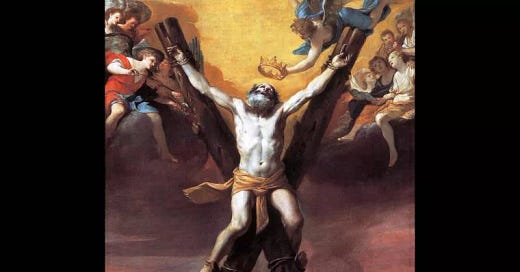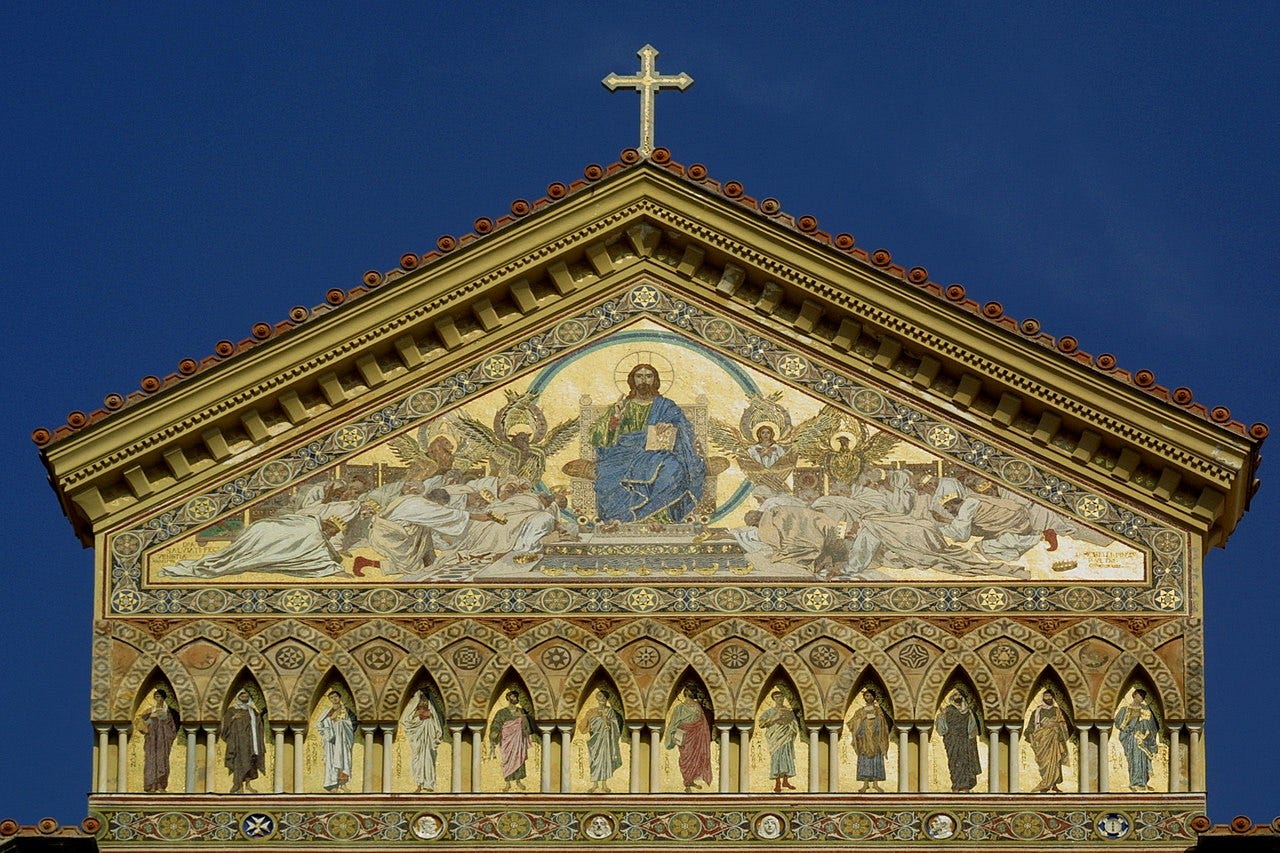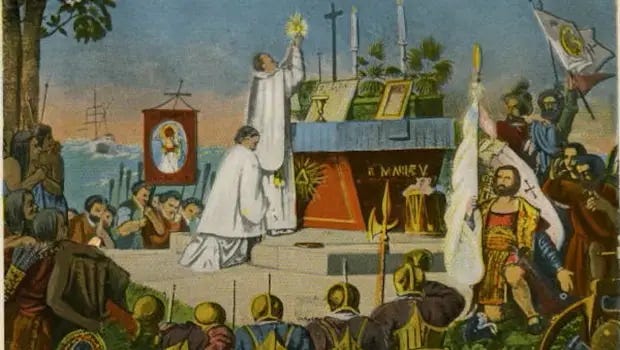In Poland, where St. Andrew's Day is known as Adrzejki, there's a tradition involving St. Andrew's Eve, the night of November 29. Girls will melt wax and pour it through the hole of a key (the antique sort, with the large holes in their handles), into a bowl of cold water. The room is darkened, a single light is lit, and then the cooled, hardened wax is pulled out and held up against the light so it casts a shadow on the wall. The resulting shadow's shape is said to indicate something about whom they'll marry.
Another Polish tradition is for unmarried girls to line up their shoes, with the first placing her shoe with its heel up against a room's back wall. The next girl places the heel of her shoe to the toe of the first girl's shoe, toward the direction of the door. The third girl does the same, and the first girl whose shoe crosses the threshold is said to be the first who'll marry (if there are too few girls to make it across the room, take shoes from the back of the line and move them to the front, toward the door).
A third Polish tradition has each unmarried girl peeling an apple, making a peel that's as long as possible. She then throws the peel over her shoulder and tries to determine what letter the shape of the peel most looks like. This letter will be the first letter of her true love's name.
In various countries (e.g., Germany, Wales, Czechoslovakia, et al.), single girls are told to listen for a dog barking; the direction whence the bark comes is the direction she'll find her future husband.
St. Andrew is not only the patron Saint of Romania, but he's also associated with wolves there, and is said to be responsible for the introduction of garlic into the area. It is customary to hang garlic about one's house and barn to keep away the spirits that roam about, and the wolves, who speak in human language, on the eve of St. Andrew's feast. And when young women go to bed that night, they will put basil under their pillows so they will dream of their husbands-to-be. Romanians will also sprout wheat seeds and force branches of fruit trees, like others do on the Feast of St. Barbara. The state of the seeds or branches on New Year's Eve is said to predict how well the new year will go.
It goes without saying that traditions like these should be done in the spirit of fun, not seriously, with any thoughts of divination.
In Amalfi, Italy, a city for whom St. Andrew is patron, a great procession is had of a Neapolitan Baroque bust of St. Andrew. It is carried from the cathedral to the sea, where fishermen are blessed and floral wreaths thrown into the water. At some point during the day, his reliquary is opened, and sometimes his remains give off a healing oil of saints. With regard to St. Andrew's relics, this phenomenon began on the eve of his feast in 1304 when an old man went to Father Pierantonio Suraldi, informed him that he would find the oil of saints on Andrew's relics, and -- disappeared (Fr. Suraldi used the oil to restore sight to a blind man from Tramonti). The evening's festivities are marked by fireworks. St. Andrew is also honored in Amalfi on June 27 in remembrance of when, in 1544, the Saint protected Amalfi by bringing about a terrible storm in the city's port when the Ottoman pirate Barbarossa tried to attack.



It is traditional for some to begin a Novena to the Immaculate Conception and/or to prepare for Christmas by beginning the Thousand Hail Mary Devotion on St. Andrew's Eve (November 29). More popularly, the St. Andrew's Christmas Novena is prayed beginning on the Feast of St. Andrew itself. This brief novena is prayed fifteen times a day, beginning on St. Andrew's Day and ending on Christmas Eve, for a total of twenty-five days in all.1
We open our Proper of Saints for Advent with Saint Andrew, because, although his feast frequently occurs before this holy season has begun, it sometimes happens that we have entered Advent when the memory of this great Apostle has to be celebrated by the Church. This Feast is therefore destined to terminate, with solemnity, the Cycle which is at its close, or to add lustre to the new one which has just begun. It seems, indeed, fitting that the Christian Year should begin and end with the Cross, which has merited for us each of those years which it has pleased the divine goodness to grant us, and which is to appear, on the last day, in the clouds of heaven, as the seal put on Time.
We should remember that Saint Andrew is the Apostle of the Cross. To Peter, Jesus has given firmness of Faith; to John, warmth of Love; the mission of Andrew is to represent the Cross of his divine Master. Now it is by these three, Faith, Love, and the Cross, that the Church renders herself worthy of her Spouse. Everything she has or is, bears this threefold character. Hence it is that after the two Apostles just named, there is none who holds such a prominent place in the universal Liturgy as Saint Andrew.
But let us read the life of this glorious fisherman of the lake of Genesareth, who was afterwards to be the successor of Christ himself, and the companion of Peter, on the tree of the Cross. The Church has compiled it from the ancient Acts of the Martyrdom of the holy Apostle, drawn up by the Priests of the Church of Patrae, which was founded by the Saint. The Churches, too, both East and West, which have inserted these Acts in their respective Offices of Saint Andrew, are of some authority, as is also Saint Bernard, who has made them the groundwork of his three admirable Sermons on Saint Andrew.Dom Prosper Gueranger
"The Liturgical Year"
Finally, we want to wish everyone a very happy Thanksgiving but we would be remiss if we did not point out the first thanksgiving was a Catholic Mass celebrated by the Spanish arriving in what is now St. Augustine, FL!
“When the first Spanish settlers landed in what is now St. Augustine on September 8, 1565, to build a settlement, their first act was to hold a religious service to thank God for the safe arrival of the Spanish fleet… After the Mass, Father Francisco Lopez, the Chaplain of the Spanish ships and the first pastor of St. Augustine, stipulated that the natives from the Timucua tribe be fed along with the Spanish settlers, including Don Pedro Menendez de Aviles, the leader of the expedition. It was the very first Thanksgiving and the first Thanksgiving meal in the United States.”2
https://fisheaters.com/feastofstandrew.html
https://aleteia.org/2016/11/22/the-first-thanksgiving-in-america-was-a-catholic-mass






